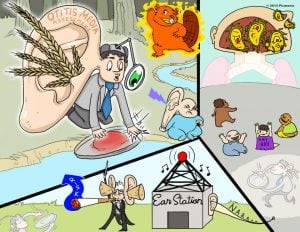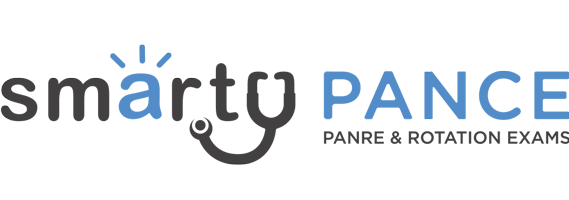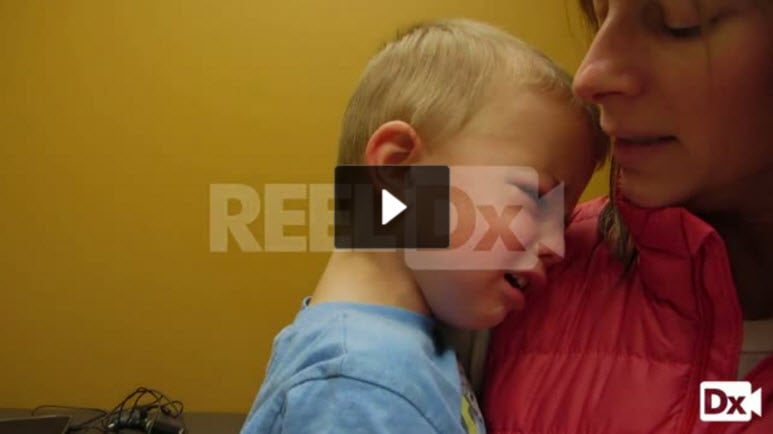
3 y/o with unilateral ear pain
Patient will present as → a 3-year-old previously healthy male is brought to your office by her mother. The mother reports the child has been crying and pulling at her right ear over the past 2 days and reports the patient has been febrile the past 24 hours. The patient’s past medical history is unremarkable, although the mother reports the patient had a “common cold” a week ago which resolved without intervention. His temperature is 101.6 F, blood pressure is 100/70 mmHg, pulse is 120/min, and respirations are 22/min. The otoscopic exam is seen here.
- Middle ear effusion (MEE) – Fluid in the middle ear cavity; MEE occurs in both AOM and otitis media with effusion (OME)
- Acute otitis media – Acute bacterial infection of middle ear fluid (also called suppurative otitis media)
- Otitis media with effusion (OME) – Middle ear fluid that is not infected; also called serous, secretory, or nonsuppurative otitis media. OME frequently precedes the development of AOM or follows its resolution. OME is very common in young children. About 90% of children have OME at some time before school age, most often between ages 6 months and 4 years
- Chronic suppurative otitis media (CSOM) – when the infection persists in the middle ear space for more than 3 months and is associated with a chronic perforation of the tympanic membrane. Pus may only be visible with a binocular microscope, or it may drain into the outer ear, presenting as otorrhea
The majority of all AOM is viral if a bacterial etiology is expected; the cause is the same as those seen in bacterial URI:
- Streptococcus pneumoniae 25%
- Haemophilus influenzae 20%
- Moraxella catarrhalis 10%
Acute vs. Chronic vs. Recurrent
- Acute: inflammation for less than 3 weeks
- Chronic: inflammation for greater than 3 months
- Recurrent: 3 episodes in 6 months or 4 episodes in 12 months with clearing between episodes
Chronic OM (> 3 months)
- Clear serous fluid in the middle ear without signs or symptoms of ear infection.
- May have hearing loss, may be asymptomatic, does not require antibiotics.
An otoscopic examination may reveal bulging, loss of landmarks, redness, injection of TM, and pus
- Key findings include bulging of the TM and limited mobility of the TM with pneumotoscopy
- Building and eventual rupture of the TM can occur as well, leading to otorrhea and abruptly decreased pain
Children:
Antibiotic therapy vs. treatment in children
| Age | Otorrhea | Severe symptoms (unilateral or bilateral) | Bilateral disease | Unilateral disease, no severe symptoms |
| < 6 months | Antibiotics | Antibiotics | Antibiotics | Antibiotics |
| 6 months to 2 years | Antibiotics | Antibiotics | Antibiotics | Antibiotics or observe 48 to 72 hours |
| ≥ 2 years | Antibiotics | Antibiotics | Antibiotics or observe 48 to 72 hours | Antibiotics or observe 48 to 72 hours |
First-line treatment for AOM in children
- Amoxicillin 90 mg/kg per day divided into two doses (maximum of 3 g/day) is the first-line drug of choice
- Augmentin 90 mg/kg per day of amoxicillin and 6.4 mg/kg per day of clavulanate divided in two doses is the first-line therapy for children with AOM who are treated with antibiotics and at increased risk of beta-lactam resistance
AOM with perforation — amoxicillin 90 mg/kg per day orally divided in two doses (we suggest a maximum of 3 g/day)
Children with a mild allergy to penicillin antibiotics
- Cefdinir 14 mg/kg per day orally in one or two doses (maximum 600 mg/day)
- Cefpodoxime 10 mg/kg per day orally in two doses (maximum 400 mg/day)
- Cefuroxime suspension 30 mg/kg per day orally divided in two doses (maximum 1 g/day)
- Cefuroxime tablets 250 mg orally every 12 hours
- Ceftriaxone 50 mg/kg intramuscularly once per day (maximum 1 g/day) for one to three doses
Azithromycin or clarithromycin for the treatment of AOM in children who have had an immediate hypersensitivity reaction or serious delayed reaction to amoxicillin or other beta-lactam antimicrobial agents
- Azithromycin 10 mg/kg per day orally (maximum 500 mg/day) as a single dose on day 1 and 5 mg/kg per day (maximum 250 mg/day) for days 2 through 5
- Clarithromycin 15 mg/kg per day orally divided into two doses (maximum 1 g/day)
Adults:
Since AOM is unusual in adults, and complications may be significant, treat all adult patients with antibiotic therapy (no observation)
First-line acute otitis media (AOM) treatment in adults
In most adults, use Augmentin 875/125 mg orally twice daily x 5 - 7 days as first-line abx.
- In patients at high risk for severe infections or infections with resistant S. pneumonia - high dose of the amoxicillin component:
- Augmentin 1000 mg/62.5 mg, extended-release, orally twice daily (for lower-weight patients and/or those with milder infections)
- Augmentin 2000 mg/125 mg, extended-release, orally twice daily (for higher-weight patients and/or those with more severe infections)
For those unable to tolerate Augmentin, alternatives include amoxicillin as initial therapy:
-
- Amoxicillin 500 mg TID or 875 mg BID x 5-7 days
- In patients at high risk for severe infections or infections with resistant S. pneumonia, Amoxicillin 1000 mg orally three times daily
In PCN allergic patients without severe reactions and who do not have a known allergy to a cephalosporin:
- Cefdinir, 300 mg orally twice daily or 600 mg once daily
- Cefpodoxime, 200 mg orally twice daily
- Cefuroxime, 500 mg orally twice daily
- Ceftriaxone, 1 to 2 g intravenously (IV) or 1 g intramuscularly (IM) once daily for three days
For patients with a known severe allergy to beta-lactam antibiotics or who have a known allergy to cephalosporins, antibiotic choices include:
- Doxycycline, 100 mg orally every BID x 5-7 days
- Azithromycin, 500 mg orally on day 1, then 250 mg orally on days 2 through 5
- Clarithromycin, 500 mg orally every BID x 5-7 days
Chronic OM:
- Treat with myringotomy with ventilation tube insertion of fluid is persistent and or hearing loss.
 Otitis media is an infection of the middle ear caused by a virus or bacteria and is characterized by the presence of fluid in the middle ear, along with symptoms of inflammation. This condition most commonly occurs in children due to the shorter, straighter, and narrower nature of the eustachian tube in childhood. Signs and symptoms of otitis media include a red, bulging tympanic membrane, ear pain, and fever. Children with an upper respiratory infection or those regularly exposed to smoke are at an increased risk of developing an ear infection. Conductive hearing loss may occur in chronic cases of otitis media. Antipyretics, analgesics, and antibiotics are typically used to treat otitis media, through irrigation of the ear, or procedures such as a myringotomy, or the placement of a tympanostomy tube may be necessary
Otitis media is an infection of the middle ear caused by a virus or bacteria and is characterized by the presence of fluid in the middle ear, along with symptoms of inflammation. This condition most commonly occurs in children due to the shorter, straighter, and narrower nature of the eustachian tube in childhood. Signs and symptoms of otitis media include a red, bulging tympanic membrane, ear pain, and fever. Children with an upper respiratory infection or those regularly exposed to smoke are at an increased risk of developing an ear infection. Conductive hearing loss may occur in chronic cases of otitis media. Antipyretics, analgesics, and antibiotics are typically used to treat otitis media, through irrigation of the ear, or procedures such as a myringotomy, or the placement of a tympanostomy tube may be necessary
Question 1 |
improve hearing | |
prevent mastoiditis Hint: Mastoiditis is prevented by early treatment of otitis media with antibiotics. | |
prevent recurrence of effusion Hint: Effusion can occur even with tympanostomy tubes in place. | |
prevent delayed language development Hint: Tympanostomy tubes have not been proven to prevent delayed language development. |
Question 2 |
bulging of the tympanic membrane Hint: Bulging and air bubbles behind the TM represent OM with effusion. | |
loss of tympanic membrane mobility | |
reddening of the tympanic membrane Hint: Reddening of the eardrum is not reliable as it may be due to crying or other vascular changes. | |
air bubbles behind the tympanic membrane Hint: See A for explanation. |
Question 3 |
ciprofloxacin (Cipro) IV | |
cefuroxime (Zinacef) IV Hint: Cefuroxime, ampicillin-sulbactam, and azithromycin have no activity against Pseudomonas. | |
ampicillin-sulbactam (Unasyn) PO Hint: Cefuroxime, ampicillin-sulbactam, and azithromycin have no activity against Pseudomonas. | |
azithromycin (Zithromax) PO Hint: Cefuroxime, ampicillin-sulbactam, and azithromycin have no activity against Pseudomonas. |
Question 4 |
Staphylococcus aureus Hint: See D for explanation. | |
Moraxella catarrhalis Hint: See D for explanation. | |
Pseudomonas aeruginosa Hint: See D for explanation. | |
Streptococcus pneumoniae |
Question 5 |
Mycoplasma pneumoniae Hint: Mycoplasma pneumoniae is a common cause of bronchitis and pneumonia. | |
Pneumocystis jiroveci Hint: Pneumocystis jiroveci is associated with immunocompromised respiratory illness. | |
Pseudomonas aeruginosa Hint: Pseudomonas aeruginosa would most commonly cause otitis externa. | |
Streptococcus pneumoniae |
|
List |
References: Merck Manual · UpToDate (children) (adults)


 Picmonic
Picmonic
